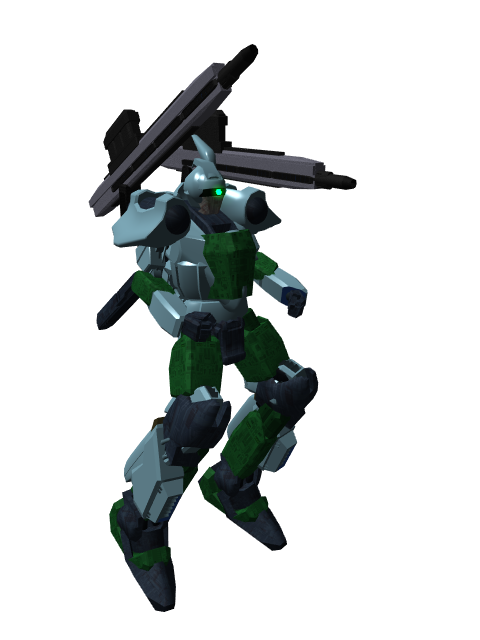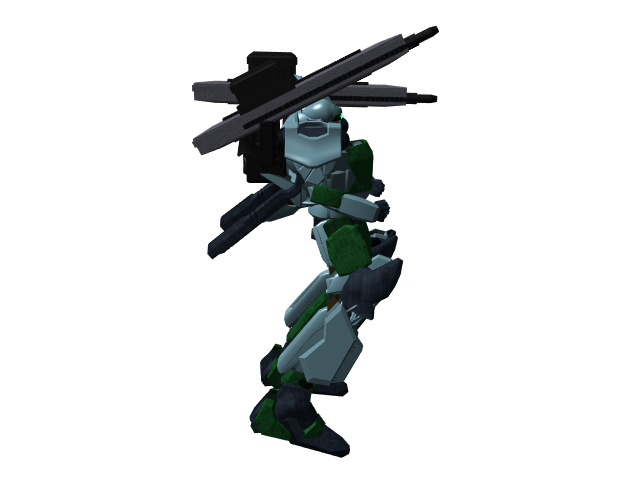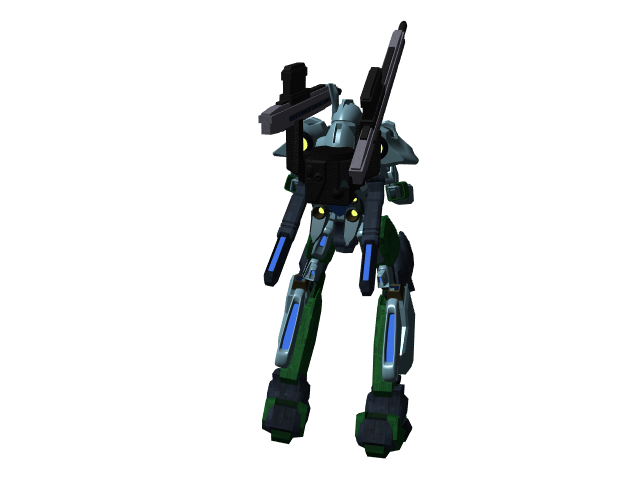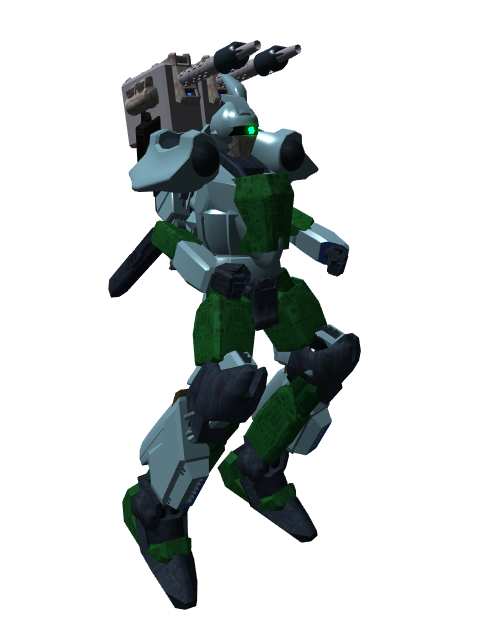Table of Contents
M4 Garuda II
Designed by Origin Industries in YE 36, the Garuda II is the successor to the older M1-3A Garuda Anti-armor support Frame.
About the Garuda II
The Garuda II is a true Generation two mechanized Frame, developed from the original M1 variant. With a lightened, strengthened chassis, more armor, better power generation, computer, and propulsion systems, as well as a more modular weapons system, it is designed to not only fill the role of its predecessor, but fill it better, and retain the capability to be updated or swapped with mission-specific loadouts.
Statistical Information
The Garuda is a commerically available armored Frame.
- Class: OI-M4-1A Garuda II
- Designer: Origin Armor Works
- Manufacturer: Origin Industries
- Fielded by: Origin, various.
- Range: 12 days on land, 6 days in space.
- Maintenance Cycle: Maintenance after every flight, overhaul every year or after major damage.
- Lifespan: 10 Years minimum.
- Cost: 55,000 KS
- Crew: The Garuda has a crew of one
- Maximum Capacity: The Life support systems are sufficient to keep two humanoid lifeforms inside the cockpit .
Appearance
The Garuda is a tall, somewhat lanky looking Frame which has mostly boxy armor plating, and a somewhat rounded chest. It has relatively small feet with large thruster vents along the backs of the calves, as well as thrusters positioned along the back of the unit. It has sloped shoulders that extend to a long, sharp edge, and has a large backpack unit which either houses two large Gauss cannons, or a large double-barreled laser cannon. Its rounded head contains an antenna and a single, glowing sensor eye.
History
The Garuda II is a modernization of the M1-3A Garuda, which itself was a modification of the original M1 Ashigaru. While physically similar looking, the Garuda II is a completely different beast from its predecessor, in terms of systems, electronics, and weaponry, and is faster, tougher, and more agile. While not as tough as contemporary designs such as the M3 Gekido or the advanced M5 Knight, it is more well protected than its predecessor and a much better unit overall.
Advantages
The Garuda II is designed as a high-mobility, heavy hitting frame that is used both for heavy anti-armor and even light anti-starship duties. Due to the ability to mount heavy weaponry on the backpack, the Garuda packs a heavy punch much beyond its own ability to handle damage, and thus, it was made to be speedy to avoid taking damage. It is the definition of a glass cannon.
Drawbacks
While the Garuda is a very heavy hitting unit, its light build and lack of heavy armor makes it rather vulnerable on the battlefield, and it must rely on its high speed and maneuverability to avoid damage rather than being able to outright defend against it. Additionally, the Garuda isn't quite as modular as its contemporaries, and requires extensive modification in order to swap its overall loadout if need arises.
Mobility
The Garuda II is a very fast, highly maneuverable armored Frame.
- Ground speed(Running ): 100 KM/h
- Ground Speed(Hover ): 200 KM/h
- Max atmospheric speed: Mach 2.1
- Max sublight speed: .35c
Size
The Garuda II is tall but lanky, without much bulk due to its overall lack of armor.
- Width: 4.3 Meters
- Height Without Cannons: 8.3 Meters
- Height With Cannons: 9.0 Meters
- Mass: 14 tons
Damage Capacity
See Damage Rating (Version 3) for an explanation of the damage system.
- Hull: Tier 7 1)
- Shields: Tier 7
Interior Descriptions
There are multiple systems inside the Garuda II which allow it to preserve its pilot and perform its job.
Cockpit
The Garuda II's Cockpit is standard, but the systems and armor configuration do not allow a two-person cockpit configuration.
Weapons Systems
While the Garuda II typically retains its standard loadout, it is modifiable to an extent and can accept some alternative handheld weapons.
Primary Weapons
The Garuda II's primary weapons are mounted on an ejectable backpack unit, which provides power, stability, and articulation for the weapons, allowing them to be aimed independently and fire in various directions. The firing arc, however, depends on which weapons system is mounted to the backpack.
Standard Configuration
The Standard configuration carries two of Origin's 125mm Gauss Cannon. Each weapon is capable of being aimed in a 200 degree arc around the mecha's vertical axis, and can cover a 10 degree arc to either side of the centerline on a horizontal axis. Each Gauss Cannon may only carry six rounds of ammunition, giving it a maximum of 12, though more ammunition may be stored elsewhere on the frame.
Space-Only Configuration
The Space-Only configuration consists of a single, modified Heavy Laser Turret, which, due to power transfer issues, fires at a much slower rate of fire, and with lower damage output, but it has effectively unlimited ammunition.
* 1x HLT with output reduced to Tier 8.
Secondary Weaponry
Aside from the main armaments, the Garuda II has some extra built-in weapons for point-defense and damaging the enemy.
- OI-M1-W3110 Gamma Ray Vulcan: x2 Tier 3
- Origin Mini-missile Pod: x2, Calf-mounted, 100 mini-missiles per pod. Tier 3
- Missile Bays: x2, shoulder-mounted. 20 missiles each pod. Tier 5
Systems Descriptions
The Garuda has a number of systems designed to allow it to perform its necessary battlefield duties while simultaneously keeping the pilot alive.
Hull and Hull Integrated Systems
Many of the systems are integrated into the hull of the Garuda.
Hull and Chassis
Endurium reinforced Durandium Alloy Outer Armor The Garuda has a thin outer armor comprised of Durandium and Endurium, produced specifically to be lightweight, yet strong and flexible.
ADNR (Aggregated Diamond Nanorods) Internal Skeleton While essentially the same build as the Asura's, the Garuda's internal skeleton is made out of lighter Aggregated Diamond Nanorods, greatly reducing the weight of the frame at the cost of its sturdiness, The Garuda's internal skeleton is reinforced to handle the recoil of the two pulse lasers.
Life Support
The Garuda has a standard life support system, with a pressurized cockpit, oxygen scrubbers, and a temperature-humidity regulation system. The Garuda also has an inertia control system to keep the g-forces on its crew to a minimum.
Shields
The Garuda uses layered electromagnetic and gravitic shielding. Each shield is generated from two tandem generator pairs within the frame. The two shield systems work in concert, allowing the frame to survive large amounts of damage.
- Locations: Lower Torso and Shoulders
- Runtime: effectively unlimited as long as the frame provides power
Power
The Garuda II has a high-output, redundant power system to ensure that it can operate effectively.
Main Power and Propulsion
The Garuda uses two Origin Industries HONEY CRUSH generators, which provide power and propulsion to the frame. The two CRUSH generators allow the Garuda to reach atmospheric speeds of mach 6.
Omni-Directional Vectored Thrusting
Ports are located on every surface of the frame. Connected to the generators, they allow the frame to travel up to .20c in any direction without changing the frame's heading; they are capable of halting the frame's forward movement and propelling it backwards, but are mainly used for maneuvering. These same thruster ports are capable of changing the frame's direction in the same time span, as well as spinning, rolling, and otherwise controlling the frame. Generally, however, the thrusters do not use the amount of power required for such maneuvers.
Plasma Conduit System
In order to transfer the plasma from the generators to weapons and auxiliary thrusters, the Garuda uses a series of Plasma Conduits which transfer plasma to the smaller auxiliary thrusters which line the back of the frame's legs. Plasma conduits also lead to plugs in the frame's hands, which connect to handheld weapons to supply them with plasma.
Secondary Power Sources
As a backup, the Garuda has three HONEY BURST generators, which in normal use supply power to the frame's electronics, but can be used to power movement of the frame's limbs and shield systems in the event the primary reactors go out.
Electronics
The Garuda uses the FATE Electronics suite to assist the pilot, easing their workload and making them that much more effective in combat. This suite has a full compliment of sensors, communications, and other electronics that provide the frame with its capabilities.
Computing
The Garuda II uses a computer core made up of Six X-type Quantum computer moduls to provide computing power for the FATE suite. these computers are linked in parallel in order to processs multiple different calculations simultaneously, due to the complex, high-speed nature of the Garuda. The Garuda's computer core is located in an armored box, just below the cockpit.
Sensors
The Garuda II uses the sensors included in the FATE Suite, which are spread out around key points of the frame's chassis to prevent all the sensors from being taken out at once.
Control Systems
The Garuda uses the Silhouette/Mirror Neural Operating Construct neural control system, which is combined with the mind-machine interface from the original Ashigaru to give the frame a highly responsive control system.
Active Mass Balance Auto Control (AMBAC)
Active Mass Balance Auto-Control (AMBAC) is a program in the Garuda's FATE electronics suite that allows for thrusterless maneuvering in the zero-G environment of space by means of precise control of limbs. AMBAC works by leveraging the Third Law of Motion (when there's an action there is an equal and opposite reaction) to effect changes in direction. AMBAC is by its nature limited to re-orienting the Frame about its center of mass, and is not a substitute for propulsion.
Automatic Stability Management
Another design feature on the Garuda, the ASM is four gyroscopes, one in each shoulder, and one in each of the Frame's thighs. The gyroscopes serve to keep the Frame steady during aiming and maneuvering. A unique feature, the ASM helps to improve the frame's stability while it's on the move.
Electronic Warfare
The Garuda uses a Compact Electronic Countermeasure Suite which is integrated into the FATE suite of electronics for electronic warfare duties.
OOC Notes
This page was originally created on 2014/03/09 18:27 by Kai.
Was approved by Kyle on 8/18/2018. Approval Thread
| Products & Items Database | |
|---|---|
| Product Categories | mecha |
| Product Name | Garuda II |
| Nomenclature | OI-M4-1A |
| Manufacturer | Origin Industries |
| Year Released | YE 36 |
| Price (KS) | 55 ,000.00 KS |



